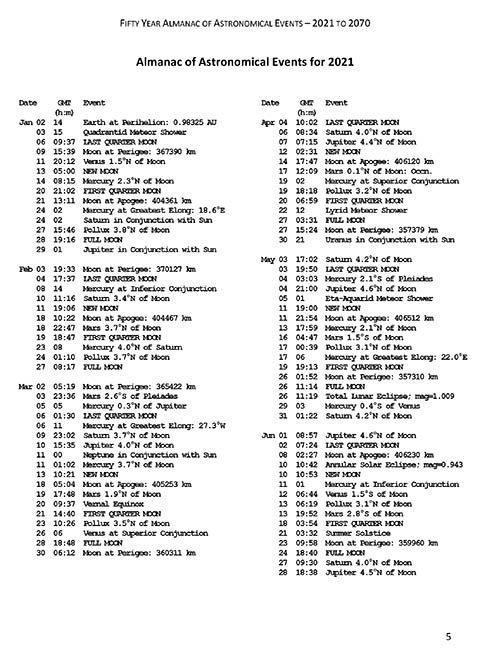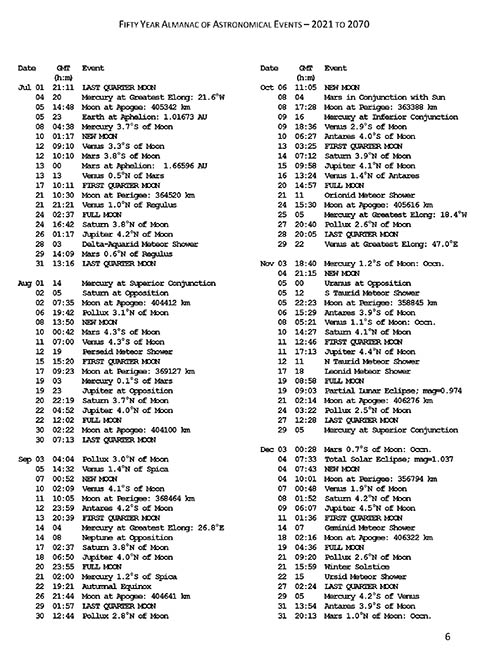Fifty Year Almanac of Astronomical Events - 2021 To 2070
The Fifty Year Almanac of Astronomical Events - 2021 To 2070 is a catalog listing a wide range of solar system phenomena as seen from Earth.
Each year gives a concise compendium of the most conspicuous and/or significant astronomical events involving the Sun, Moon and the planets.
The astronomical events include the following.
- solar and lunar eclipses
- phases of the Moon
- apogees and perigees of the Moon
- Equinoxes and Solstices of Earth
- aphelion and perihelion (Earth, Mars, Jupiter, Saturn and Uranus)
- oppositions and conjunctions of the planets
- elongations of Mercury and Venus
- close conjunctions of the Moon with the planets and bright stars
- close conjunctions of planets with bright stars and other planets
- peak of major meteor showers
The date and time of each event is given in Greenwich Mean Time (= Coordinated Universal Time).
With 200+ events each year, the Fifty Year Almanac includes over 10,200 astronomical events.
The Fifty Year Almanac of Astronomical Events is based on the Astropixels.com web resource Sky Event Almanacs.
Accuracy of the Fifty Year Almanac
The goal of the Fifty Year Almanac of Astronomical Events is to present a wide range of solar system phenomena with practicable accuracy.
In general, events listed to the nearest hour are accurate to ± 30 minutes.
Events listed with a precision in hours and minutes (i.e., hh:mm) are typically accurate to ± 5 minutes or less.
The following table gives a more detailed breakdown of the accuracy of times for various astronomical events.
|
Accuracy of the Fifty Year Almanac of Astronomical Events |
| Solstice/Equinox (Earth) | ± 0.5 minute |
| Aphelion/Perihelion (Earth) | ± 30 minutes; ± 0.00001 AU |
| Solar and Lunar Eclipses | ± 0.5 minute |
| Phases of the Moon | ± 0.5 minute |
| Moon at Nodes | ± 2 minutes |
| Apogee/Perigee of Moon | ± 5 minutes; ± 5 kilometers |
| Conjunctions of Moon with Star or Planet | ± 10 minutes |
| Conjunctions of Planet with Planet | ± 3 hours |
| Inferior/Superior Conjunctions (Mercury & Venus) | ± 30 minutes |
| Greatest Elongation (Mercury & Venus) | ± 30 minutes |
| Opposition/Conjunction (Outer Planets) | ± 3 hours |
| Aphelion/Perihelion of Planets | ± 30 minutes |
Algorithms used in predicting many of the astronomical events are based on
Astronomical Algorithms by Jean Meeus (Willmann-Bell Inc. Richmond 1998).
In some cases where higher accuracy is required (e.g., eclipses, aphelion and perihelion), the predictions use the Jet Propulsion Laboratory's DE430 -
the same computer ephemeris used to guide planetary spacecraft missions across the Solar System.
The Fifty Year Almanac of Astronomical Events is based on the Astropixels.com resource web Sky Event Almanacs.
Fifty Year Almanac: Sample Pages
Below are two sample pages from the Fifty Year Almanac.
They cover astronomical events for the year 2021
Click on each to open a full-resolution page in PDF format.
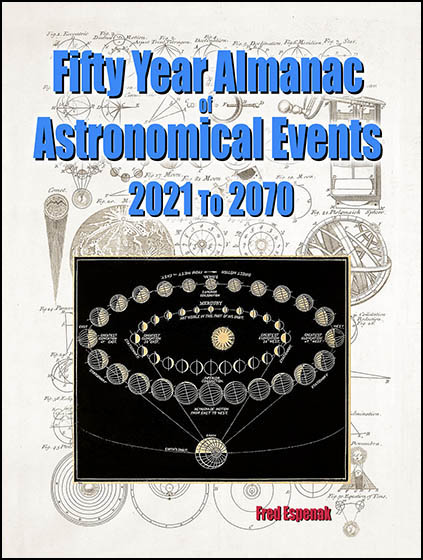
Link for Ordering the Fifty Year Almanac of Astronomical Events
Below is a link for ordering the Fifty Year Almanac from Amazon.com:

The links above are for Amazon.com. However, you can order these books from any Amazon worldwide.
Visit any Amazon and enter "Fifty Year Almanac of Astronomical Events" in Amazon's search window.
|
About the Author
Click the following link to read a brief biography on Fred Espenak.
Also Available...
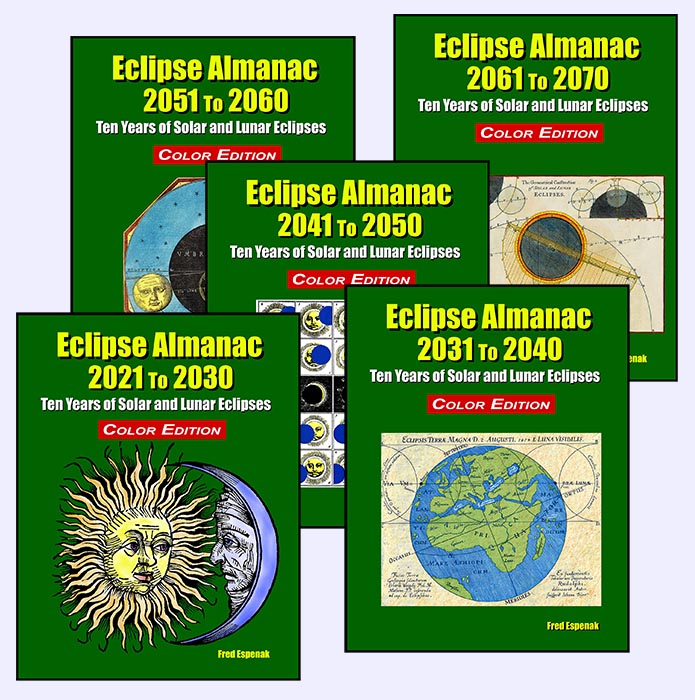
Eclipse Almanac
The Eclipse Almanac is a series of five publications.
Each one is a concise reference for every eclipse of the Sun and the Moon over a 10-year period.
This compendium identifies when and where each of these events will be seen.
Particular details about each eclipse are included, as well as a 25-year table looking further into the future.
Section 1 presents solar eclipses including an explanation of why they occur, types of solar eclipses, and the visual appearance of each.
Global maps depict the geographic regions of visibility of each of the 22 to 23 solar eclipses.
Section 2 covers lunar eclipses explaning why they occur, the types of lunar eclipses, and the appearance of each.
Detailed figures illustrate each of the 22 to 23 lunar eclipses including the Moon's path through Earth's shadows, and a map of the geographic visibility of every eclipse.
Section 3 lists the date and time of the Moon’s phases over the decade.
The five volume Eclipse Almanac series covers the decades from 2021 to 2070.
For more information visit Eclipse Almanac.
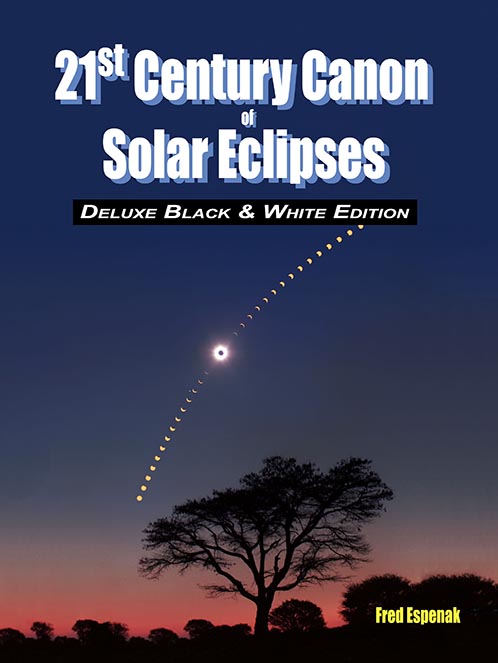
21st Century Canon of Solar Eclipses
The 21st Century Canon of Solar Eclipses contains maps and data for all 224 solar eclipses occurring during the 100-year period from 2001 through 2100.
The eclipse predictions are based on the Jet Propulsion Lab's DE405 - a computer ephemeris used for calculating high precision coordinates of the Sun and Moon for hundreds of years into the past and future.
Section 1 of the Canon presents the fundamentals about solar eclipses.
Section 2 discusses the eclipse the predictions, the constants used. A statistical analysis of eclipse frequency, extremes in eclipse magnitude, greatest central duration and quincena combinations are covered in Section 3. A concise explanation of the data contained in the solar eclipse catalog (Appendix A) and detailed descriptions of the solar eclipse maps.
The primary content of the "21st Century Canon" resides in the four appendices.
Appendix A is a comprehensive catalog of solar eclipses.
Appendix B is an atlas of maps (12 per page) depicting the geographic regions of visibility of each eclipse.
Appendix C zeros in on full-page maps each solar eclipse.
Curves of Maximum Time and Curves of Eclipse Magnitude permit the estimation of time and magnitude from any geographic location. Finally, Appendix D plots the track of every central eclipse (total, annular and hybrid) on large scale maps to allow the identification of countries and major cities within each eclipse path.
For more information visit 21st Century Canon of Solar Eclipses.
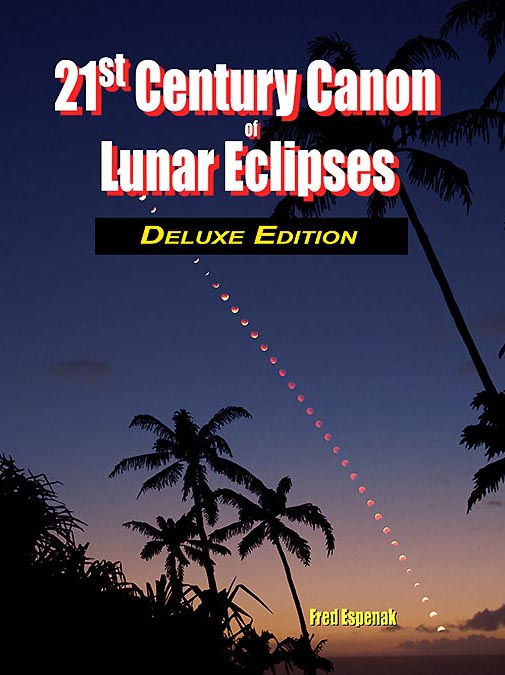
21st Century Canon of Lunar Eclipses
The 21st Century Canon of Lunar Eclipses contains figures, maps and data for all 228 lunar eclipses occurring during the 100-year period from 2001 through 2100.
The eclipse predictions are based on the Jet Propulsion Lab's DE431 - a computer ephemeris used for calculating high precision coordinates of the Sun and Moon for hundreds of years into the past and future.
Section 1 of the Canon presents the fundamentals about lunar eclipses.
Section 2 discusses the eclipse the predictions and the enlargement of Earth's shadows.
An analysis of eclipse frequency, and the extremes in penumbral and umbral eclipse magnitudes, and durations of penumbral, partial and total eclipses are covered in Section 3.
The primary content of the "21st Century Canon" resides in the three appendices.
Appendix A is a comprehensive catalog of lunar eclipses.
Appendix B is an atlas of diagrams (12 per page) depicting the Moon's path through Earth's shadows and the geographic region of visibility of each eclipse.
Appendix C zeros in on the lunar eclipses with a detailed full-page path diagrams and maps of each eclipse.
For more information visit 21st Century Canon of Lunar Eclipses.
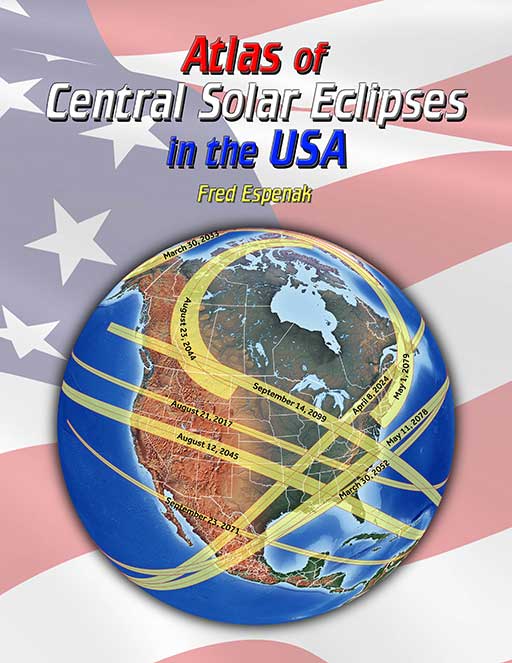
Atlas of Central Solar Eclipses in the USA
The Atlas of Central Solar Eclipses in the USA contains of a series of 499 global maps showing the geographic track of every total and annular solar eclipse across the USA (including Alaska and Hawaii) during the two-thousand-year period 1001 through 3000. It is accompanied by a catalog that lists the major characteristics of each eclipse including its duration and whether it is visible from the lower 48 states, Alaska and/or Hawaii.
A set of 20 detailed maps, each covering a 50-year period and centered on the lower 48 states, shows the path of every total and annular eclipse. The maps include state boundaries and major cities. These maps also cover southern Canada and northern Mexico.
For more information visit Atlas of Central Solar Eclipses in the USA.
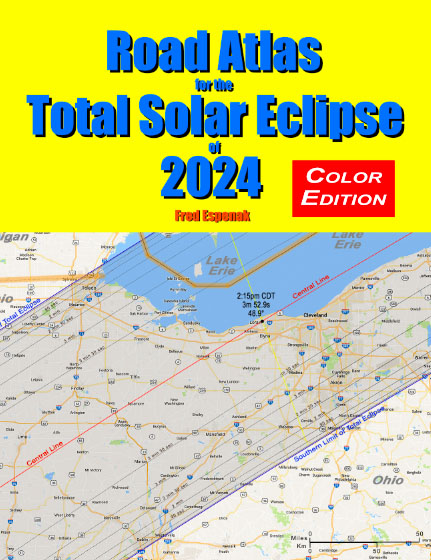
Road Atlas of the Total Solar Eclipse of 2024
The Road Atlas for the Total Solar Eclipse of 2024 contains a comprehensive series of 26 maps of the path of totality across Mexico, the USA and Canada.
The large scale (1 inch ≈ 22 miles) shows both major and minor roads, towns and cities, rivers, parks, and mountains.
Although a partial eclipse will be seen from all of North America, the total phase in which the Moon completely covers the Sun (known as totality) will only be seen from within the 120-mile-wide path of the Moon’s umbral shadow
as it sweeps across Mexico, the United States (Texas, Oklahoma, Arkansas, Missouri, Tennessee, Kentucky, Illinois, Indiana, Ohio, Michigan, Pennsylvania, New York, Vermont,
New Hampshire, and Maine), and Canada (Ontario, Quebec, New Brunswick, Prince Edward Island, Nova Scotia and Newfoundland).
Armed with this atlas and the latest weather forecasts, the road warrior is ready to chase totality no matter where it takes him/her along the entire path.
This mobile strategy offers the highest probability of witnessing the spectacular 2024 total eclipse in clear skies.
For more information visit Road Atlas for the Total Solar Eclipse of 2024.
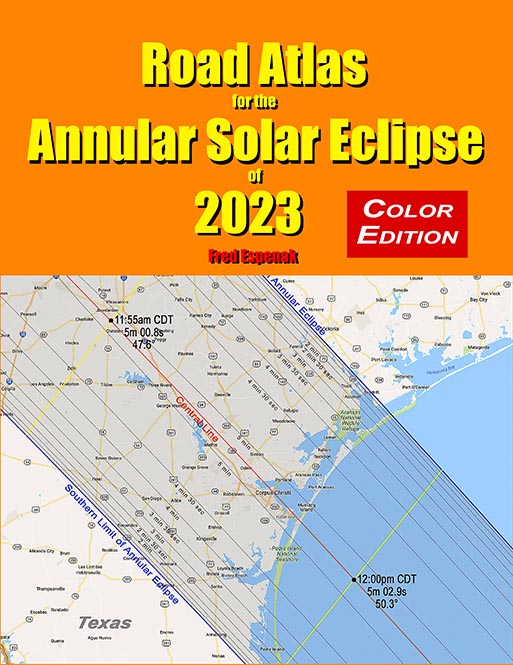
Road Atlas of the Annular Solar Eclipse of 2023
The Road Atlas for the Annular Solar Eclipse of 2023 contains a series of 29 maps of the path of annularity across the USA, Mexico, Central and South America.
The large scale (1 inch ≈ 28 miles) shows both major and minor roads, towns and cities, rivers, parks, and mountains.
The annular eclipse phase in which the Moon is completely silhouetted in front of the Sun (known as annularity) will only be seen from within the 115 to 137 mile-wide path of the Moon’s antumbral shadow
as it sweeps across the United States (Oregon, California, Idaho, Nevada, Utah, Colorado, Arizona, New Mexico, and Texas), Mexico, Central and South America.
Armed with this atlas and the latest weather forecasts, the road warrior is ready to chase annularity no matter where it takes him/her along the entire path.
This mobile strategy offers the highest probability of witnessing the amazing 2023 annular eclipse in clear skies.
For more information visit Road Atlas for the Annular Solar Eclipse of 2023.
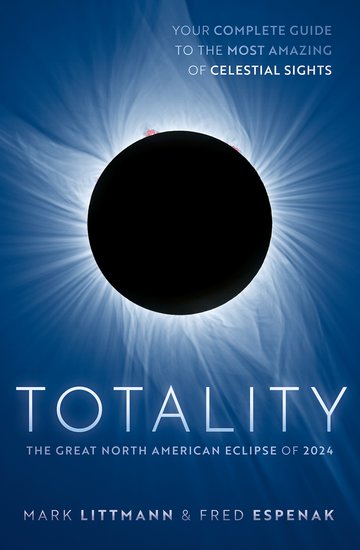
Eclipse Bulletin: Total Solar Eclipse of 2017 August 21
The Eclipse Bulletin: Total Solar Eclipse of 2017 August 21 is the complementary publication of the
2017 Road Atlas and is the ultimate guide to this highly anticipated event.
Local circumstances tables for more than 1000 cities across the USA provide times of each phase of the eclipse along with the eclipse magnitude, duration and Sun's altitude.
Additional tables cover the eclipse circumstances for cities in Canada, Mexico, Central and South America and Europe.
An exhaustive climatological study identifies areas along the eclipse path where the highest probability of favorable weather may be found.
A travelogue highlights key locations in the eclipse track from Oregon through South Carolina.
Finally, comprehensive information is presented about solar filters and how to safely observe and photograph the eclipse.
For more information visit Eclipse Bulletin: Total Solar Eclipse of 2017 August 21.

Totality - The Great North American Eclipse of 2024
The Totality - The Great North American Eclipse of 2024 is a complete guide to the spectacular total eclipse of April 8, 2024 that passes across the United States, Mexico and Canada.
The book provides information, photographs, and illustrations to help understand and safely enjoy all aspects of this eclipse including:
- How to observe a total eclipse of the Sun
- How to photograph and video record an eclipse
- Why solar eclipses happen
- The earliest attempts to understand and predict eclipses
- The mythology and folklore of eclipses
- The response of man to total eclipses through time
- How scientists used total eclipses to understand how the Sun works
- How astronomers used a total eclipse to confirm Einstein's general theory of relativity
- Weather prospects for the 2024 eclipse
- Detailed maps of the path of totality for the 2024 eclipse
- Precise local times for the 2024 eclipse (the next total solar eclipse to visit the U.S.)
- Color and black-and-white photographs, diagrams, and charts to illustrate and explain total solar eclipses
- Global maps of total solar eclipses from 2024 to 2045 and lists of total and annular solar eclipses from 1970 through 2070
For more information visit Totality - The Great North American Eclipse of 2024.
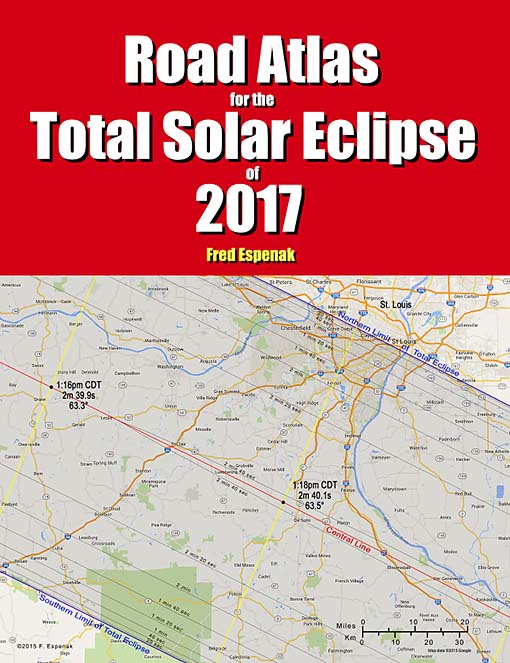
Road Atlas for the Total Solar Eclipse of 2017
The Road Atlas for the Total Solar Eclipse of 2017 is a complementary publication of the
2017 Eclipse Bulletin.
It contains a comprehensive series of 37 high resolution, full color maps of the path of totality across the USA.
The large scale (1:700,000 or 1 inch = 11 miles) shows both major and minor roads, towns and cities, rivers, parks, and mountains.
Armed with this atlas and the latest weather forecasts, the road warrior is ready to chase totality no matter where it takes him/her along the 2500-mile-long path.
This mobile strategy offers the highest probability of witnessing the spectacular 2017 total eclipse in clear skies.
For more information visit Road Atlas for the Total Solar Eclipse of 2017.


